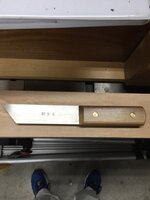Warren White
Member
... I can't seem to figure this thing out. I have looked for videos that may explain how to use this tool, but don't see any. It isn't like this tool (or a similar tool) isn't sold in lots of places.
Which side goes up? How is it presented?
Dang lathe grabbed it out of my hand twice, so something is wrong with the presentation.
Any help would be MOST appreciated!
Which side goes up? How is it presented?
Dang lathe grabbed it out of my hand twice, so something is wrong with the presentation.
Any help would be MOST appreciated!

